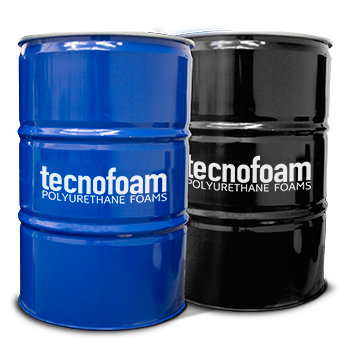GENERAL SPECIFICATIONS
- It is a spray polyurethane foam system(SPF)with high mechanical properties covering the surfaces
- The application and training is done by our spray equipment TC2049 (spray-equipment.tecnopolgroup.com) or similar
- With its continuous application, joints and any type of union between applications are saved, providing a surface with optimal protection parameters.
- The blowing agent is water. It is free from harmful to the ozone layer, so do not promote the greenhouse effect (NOT contain HFCs, HCFCs, VOCs, etc ...); it does not emit any substance to the environment once installed. The applied system is 100% recyclable by mechanical means friendly to the environment. No gas collection for recycling and/or destruction is required
- The properties of the polyurethane foam system allow it to adhere to any surface such as concrete, ceramic, metal, polyurethane foam, wood, acrylic paints (checking the situation of areas recommended).
- Foam applied without allowing for cooling may result in excess heat build-up and result in fire or the generation of offensive odors that may not dissipate with time.
- Recommended thickness: 5 -10 mm
- Contractors and applicators must comply with all applicable and appropriate guidelines for processing, handling guidelines.
PACKAGING
Metal drums of 220 kg for the polyol, and 250 kg for the isocyanate.
STORAGE AND SHELF LIFE
Store the drums in original containers in a dry environment at a temperature between 5-35 ºC (41-95°F). Keep away from direct sunlight, extreme heat, cold or moisture otherwise they may be affected its reactivity and performance. Prior to application, B side must be thoroughly mixed with a drum mixer before inserting the transfer pumps and use. This step is very important, please consult your representative for recommendations. Low ambiance temperature increase the viscosity of the polyol, which makes it difficult to mix and apply, and can generate crystallization in the isocyanate, which can cause its mixing ratio to vary and the consequent internal problems in the mixing and application equipment . Very high temperatures can modify polyols, causing loss of the blowing agent, increasing consumption, and producing the swelling of the metallic drum. To avoid these last situations, it is recommended to let the drums for a while before use, in a cool and ventilated place. These are the shelf life times for both components:
- POLYOL COMPOUND: 6 months (stirr before use and also during the application)
- ISOCYANATE COMPOUND: 6 months
APPLICATION METHOD
The application of this polyurethane foam system should be performed under the non-presence of moisture or water from the support stand on which to apply either at the time of application as a posteriori. The substrate must be clean and free of dust, oils or greases. The polyurethane foam system adheres strongly to most common building materials such as wood, steel, OSB, plywood, fiber cement, interior masonry, itself and on lower density systems polyurethane. Metal surfaces should be protected with an anti-rust primer before being covered with foam. On smooth surfaces without pores, galvanized sheet, polypropylene, etc..., a primer must be applied to ensure adhesion. In case of existence of expandion joints, they must be covered with a non adhesive plastic tape to avoid breaks in the SPF due to the movement of the support. Minimum recommended substrate temperature must be 5 to 40ºC (41-104ªF). In applications with high-temperature gradients, a vapor barrier is placed on the warm side of the insulation to prevent condensation. The thickness that can be made per layer is approx. 10mm, until the desired total thickness is achieved as successive layers are applied. For the spraying of the next layer, the temperature of the first should be approximately 35-40ºC (95-104ºF)or wait 3-4 minutes for it to drop. The desired total thickness must be defined by the project according to its specifications. At all times the applicator must comply with local regulations depending on the use, taking into account the physicochemical characteristics of the polyurethane foam system to be used.
APPLICATION REQUIREMENTS (proportioner)
It is necessary to mix the two initial liquid components using a high-pressure plural component proportioner; isocyanates and polyols must be mixed 1:1 in volume using our spray equipment TC2049 (spray-equipment.tecnopolgroup.com) or similar (proper maintenance and cleaning it is recommended). The general parameters for material area as follows:
- Isocyanate heater temperature:40-45 ºC (104 to 113ºF)
- Polyol heater temperature:45-55ºC 113 to 131ºF)
- Hose temperature:40-50ºC (104 to 122ºF)
- Working pressure: 1.450-1.750 psi (100 - 120 bar)
- Mixing chamber (recommended): GU-07008-2
These temperatures and pressure parameters must be valued, ratified or slightly varied by the applicator, depending on the conditions of each climatic zone, weather situation or according to the specifications of the projection equipment. It is the responsibility of the owner / applicator of the equipment to keep it in perfect condition in order to maintain the correct mixing ratio of the two components that Tecnopol delivers separately, by periodically updating its maintenance controls. During the execution of the application, it may be necessary to correct these parameters according to changing external conditions, as well as to verify the correct operation of the machine (pressure and temperature). The part B must be thoroughly mixed with an mechanical mixer before inserting transfer pumps. Isocyanate are sensitive to moisture, ensure the drums and spray equipment are protected from moisture during storage and application. Store and clean proportioner by manufacturer’s suggested guidelines.
HEALTH AND SAFETY
Respiratory Protection: When handling or spraying use an air-purifying respirator. Skin protection: Use rubber gloves, remove immediately after contamination. Wear clean body-covering. Wash thoroughly with soap and water after work and before eating, drinking, or smoking. Eye / Face: Wear safety goggles to prevent splashing and exposure to particles in the air. Waste: Waste generation should be avoided or minimized. Incinerate under controlled conditions in accordance with local laws and national regulations. Re-occupancy of the work site without respiratory equipment is minimum 24 hours providing the correct ventilation for the area sprayed. Contractors and applicators must comply with all applicable and appropriate guidelines for storage and safety guidelines.These safety recommendations for handling, are necessary for the implementation process as well as in the pre and post, on exposure to the loading machinery. Dispose waste in accordance with star or/and local regulations.
COMPOUNDS CHARACTERISTICS
|
CHARACTERISTIC
|
POLYOL
|
ISOCYANATE
|
|
Viscosity at 25ºC BROOKFIELD VISCOSIMETER
|
<500 mPas.
|
180-250 mPas.
|
|
NCO content ISO 14896
|
-----
|
30~32 %
|
| Specific weight |
1.09 g/cm³ |
1.23 g/cm³ |
Results were performed in the laboratory at 23ºC (73ªF) and 50% RH, under controllable conditions. These values may vary depending on the application, climatology, or substrate conditions.
APPLIED SYSTEM CHARACTERISTICS
|
CHARACTERISTIC
|
VALUE
|
| Mixing ratio (polyol:isocyanate) |
100 : 100 in volume / 100 : 111 in weight
|
| Cream/stirring time |
3 ~ 5 secs |
|
Gel timeTack-free time
|
8 ~ 12 secs / 11 ~ 17 secs
|
|
Free density / Appplied density
|
70 ~100 kg/m³ / 90 ~150 kg/m³
|
| Compressive strength |
>800KPa |
| Environmental or substrate range of temeprature |
5 ~ 40ºC (41~104ªF) |
| Dew point |
0 |
Results were performed in the laboratory at 23ºC (73ªF)and 50% RH, under controllable conditions. These values may vary depending on the application, climatology, or substrate conditions.









